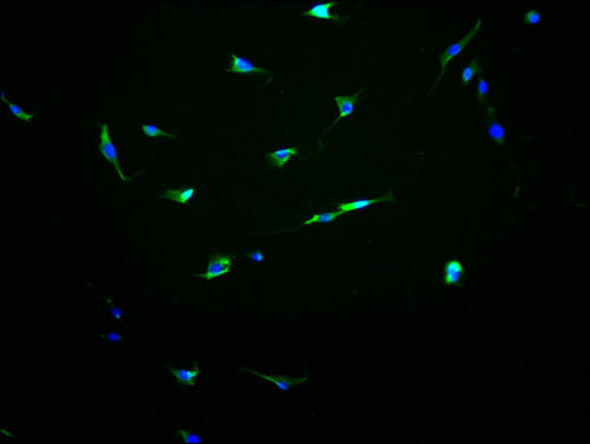Description
| Antibody Name: | MTNR1B Antibody (PACO06633) |
| Antibody SKU: | PACO06633 |
| Size: | 50ug |
| Host Species: | Rabbit |
| Tested Applications: | ELISA, WB |
| Recommended Dilutions: | ELISA:1:5000, WB:1:500-1:2000 |
| Species Reactivity: | Human |
| Immunogen: | Synthesized peptide derived from the C-terminal region of human MEL-1B-R. |
| Form: | Liquid |
| Storage Buffer: | Liquid in PBS containing 50% glycerol, 0.5% BSA and 0.02% sodium azide. |
| Purification Method: | The antibody was affinity-purified from rabbit antiserum by affinity-chromatography using epitope-specific immunogen. |
| Clonality: | Polyclonal |
| Isotype: | IgG |
| Conjugate: | Non-conjugated |
 | Western Blot analysis of HELA A549 cells using MEL-1B-R Polyclonal Antibody. |
 | Western Blot analysis of HepG2 cells using MEL-1B-R Polyclonal Antibody. |
| Synonyms: | MTNR1B; Melatonin receptor type 1B; Mel-1B-R; Mel1b receptor |
| UniProt Protein Function: | MTNR1B: High affinity receptor for melatonin. Likely to mediates the reproductive and circadian actions of melatonin. The activity of this receptor is mediated by pertussis toxin sensitive G proteins that inhibit adenylate cyclase activity. Belongs to the G-protein coupled receptor 1 family.Protein type: Membrane protein, integral; Receptor, GPCR; Membrane protein, multi-pass; GPCR, family 1Chromosomal Location of Human Ortholog: 11q21-q22Cellular Component: cytosol; integral to plasma membrane; plasma membraneMolecular Function: G-protein coupled receptor activity; melatonin receptor activity; protein bindingBiological Process: camera-type eye development; cell surface receptor linked signal transduction; circadian rhythm; G-protein signaling, coupled to cyclic nucleotide second messenger; glucose homeostasis; negative regulation of cGMP metabolic process; negative regulation of insulin secretion; negative regulation of neuron apoptosis; negative regulation of transmission of nerve impulse; positive regulation of circadian sleep/wake cycle, non-REM sleep; positive regulation of transmission of nerve impulse; positive regulation of vasodilation; reduction of cytosolic calcium ion concentration; regulation of insulin secretion; synaptic transmissionDisease: Diabetes Mellitus, Noninsulin-dependent |
| UniProt Protein Details: | |
| NCBI Summary: | This gene encodes one of two high affinity forms of a receptor for melatonin, the primary hormone secreted by the pineal gland. This gene product is an integral membrane protein that is a G-protein coupled, 7-transmembrane receptor. It is found primarily in the retina and brain although this detection requires RT-PCR. It is thought to participate in light-dependent functions in the retina and may be involved in the neurobiological effects of melatonin. [provided by RefSeq, Jul 2008] |
| UniProt Code: | P49286 |
| NCBI GenInfo Identifier: | 1346548 |
| NCBI Gene ID: | 4544 |
| NCBI Accession: | P49286.1 |
| UniProt Secondary Accession: | P49286 |
| UniProt Related Accession: | P49286 |
| Molecular Weight: | 40,188 Da |
| NCBI Full Name: | Melatonin receptor type 1B |
| NCBI Synonym Full Names: | melatonin receptor 1B |
| NCBI Official Symbol: | MTNR1B |
| NCBI Official Synonym Symbols: | MT2; FGQTL2; MEL-1B-R |
| NCBI Protein Information: | melatonin receptor type 1B |
| UniProt Protein Name: | Melatonin receptor type 1B |
| UniProt Synonym Protein Names: | |
| Protein Family: | Melatonin receptor |
| UniProt Gene Name: | MTNR1B |
| UniProt Entry Name: | MTR1B_HUMAN |






